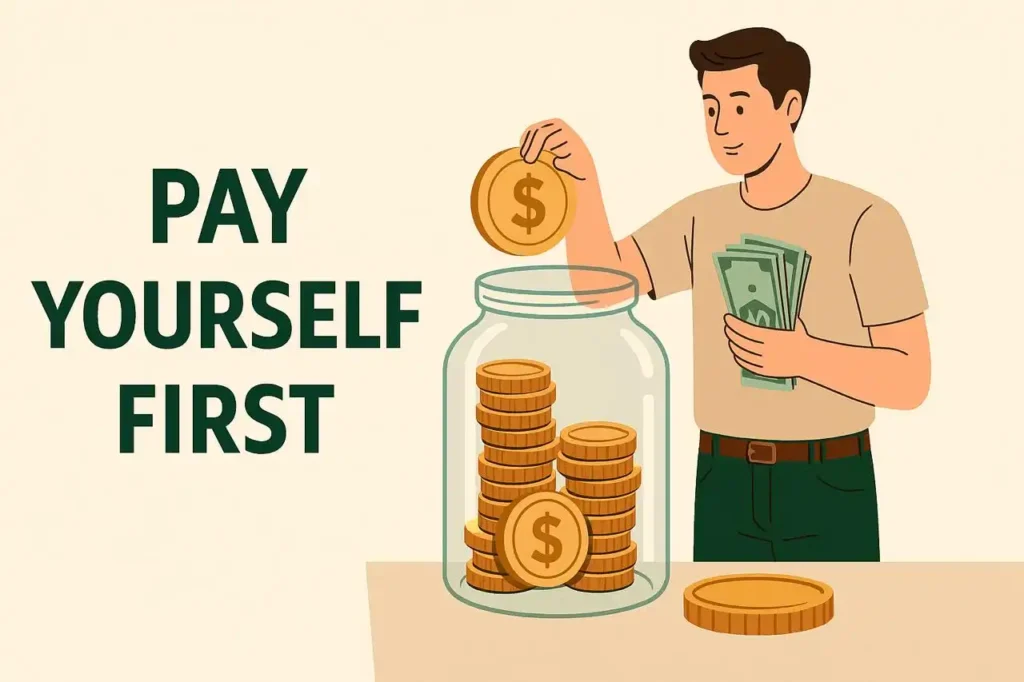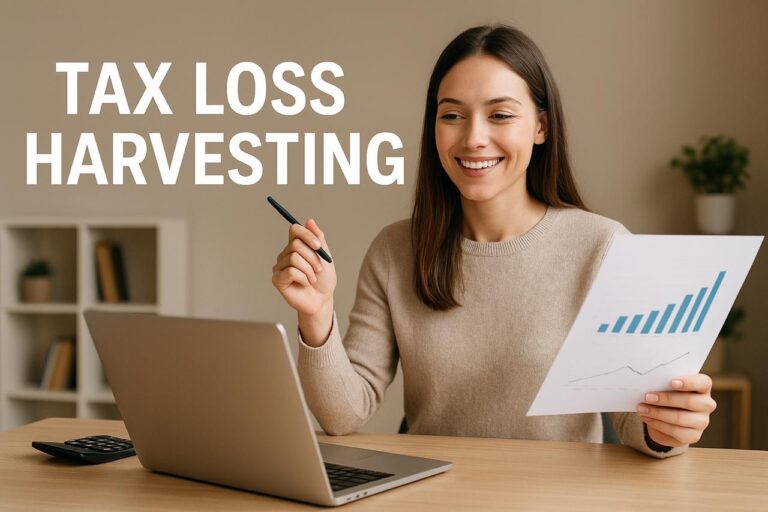Originally Published: February 2025 | Last Updated: August 2025
Your Proven Blueprint to Get Rich — One Smart Step at a Time
The Morning You Decide
One rainy morning, Marcus — a 32-year-old school teacher in Ohio — realized he did not know how much he actually saved each month. He was good at being busy, not good at being wealthy. He did not have a flashy side gig or a startup. He had a paycheck, a dream, and a growing anxiety about money.
That morning he did three tiny things, as he understood to build wealth in 3 simple steps: set up an automatic transfer, opened a low-cost investment account, and read one article about compound interest. Two years later he moved from “one day” dreams to a plan with milestones.

If Marcus can change his financial course, so can you.
This is not get-rich-quick. This is a real plan for busy people, families, and anyone who wants to stop living paycheck-to-paycheck and start making money work for them. By the end you will have exact action items, a 7-day starter challenge, and long-term strategies that actually scale.
Step 1 — Pay Yourself First: Make Tomorrow Non-Negotiable
The idea that changes everything
Most people save what’s left after spending. That’s how savings never happen. The smarter move is automatic: pay yourself first — move a fixed portion of every paycheck to savings/investment before you pay bills, buy coffee, or impulse-shop.

Why this works (psychology + math)
• Automation removes temptation. You can not spend what’s automatically moved.
• Consistency compounds. Small amounts add up: $100/month is $1,200 a year; $100/month invested at a modest 6% average return becomes $23,345 in 30 years.
• It reorders priorities. Your future self receives first priority — not the landlord, not Netflix, not the impulse buy.
A short, real-feel story
Jill, a 27-year-old nurse in Texas, used to tell herself “I will start saving after I get a raise.” Years passed. One day she automated $50 per paycheck to a “Future Me” savings account. She did not notice the money missing and it quietly grew. After a year she had $1,200 and the confidence to invest.
Exact dollar-first steps you can implement today
1. Choose a target: Start with 10% of net income. If that’s impossible, start with a fixed amount: $50 or $100 per paycheck.
2. Open two accounts: (A) Emergency Savings (liquid), (B) Investment Account (brokerage/IRA).
3. Automate transfers: Set the bank to move your “pay yourself first” amount the day your paycheck arrives.
4. Label the account: Call it “Freedom Fund” or “Future Travel”—names increase emotional buy-in.
5. Gradually increase: On every raise, route 50% of the raise to savings/investments.
Examples
• If you earn $3,000 net/month and save 10%/month = $300/month = $3,600/year.
• If you start at $300/month and increase by $50 every year, your annual investment grows without pain.
Step 2 — Invest Wisely: Turn Savings into Growth
The core truth
Saving protects. Investing grows. If your cash only sits in a bank earning near-zero interest, inflation reduces its purchasing power. Investing intelligently lets your money beat inflation and grow into meaningful wealth.
Beginner-friendly investment options
• Broad-market index funds & ETFs (e.g., S&P 500 index funds): Low-fee, diversified, and historically reliable for long-term growth.
• Roth IRA / Traditional IRA / 401(k): Tax-advantaged retirement accounts. Prioritize employer 401(k) match first — that’s “free money.”
• Target-date funds: A set-it-and-forget-it choice for retirement investing.
• High-yield savings or short-term CDs: For near-term goals (3–12 months).
• Dividend-paying stocks or REITs: For future passive income (advanced beginner).
• Robo-advisors: Automated portfolios that rebalance and often cost less than full-service advisors.
The safe starter portfolio (for a typical beginner)
• 60% U.S. equities (e.g., S&P 500 ETF)
• 20% International equities (ETF)
• 20% Bonds or short-term Treasury funds (for stability)
Start small. Start consistent. Monthly investments via automatic transfers (like $100–$500/month) beat trying to time the market.
Action steps — first 90 days (step-by-step)
1. Emergency fund: Save 3 months of basic expenses in a high-yield savings account before aggressive investing. If you have debt, prioritize high-interest debt repayment first.
2. Open accounts: If you have a 401(k) at work, contribute at least enough to get the employer match (e.g., if employer matches 50% up to 6%, contribute 6%). Open an IRA if you can.
3. Pick funds: Choose 1–2 low-cost ETFs or index funds for your brokerage account. Examples: Vanguard Total Stock Market ETF (VTI), Schwab U.S. Broad Market ETF (SCHB).
4. Set up automatic investments: $100–$500/month into your chosen ETFs/IRAs.
5. Avoid fees: Use commission-free platforms and low expense ratio funds.
Projection example
Suppose you invest $200/month into a total stock market index fund with an average annual return of 7% (after inflation).
• After 10 years → ~$34,500
• After 20 years → ~$92,000
• After 30 years → ~$235,000
Same contribution. Longer time horizon = dramatically larger balance.
Common beginner mistakes and how to avoid them
• Mistake: Buying into “hot tips.”
Fix: Use broadly diversified index funds.
• Mistake: Checking daily and panicking during dips.
Fix: Review quarterly; set a long-term target.
• Mistake: High-fee funds.
Fix: Compare expense ratios — even 1% vs. 0.05% makes a massive difference long term.
Tactical invest-more tips
• Max out tax-advantaged accounts when possible ($6,500 per year for Roth IRA under age limits in 2024; 401(k) limits differ — check current IRS caps).
• Use catch-up contributions if you are over 50.
• Automate paycheck increases: route part of raises directly to investments.
Step 3 — Let Compound Interest Be Your Superpower
Why compounding matters
Compound interest: your investment returns earn returns. Over time, the effect is exponential.
A clear example (accurate, conservative)
You invest $250/month in a diversified portfolio averaging 7% annually (a reasonable long-term conservative estimate after inflation):
• 10 years: ~$43,500
• 20 years: ~$1.31,000
• 30 years: ~$3,06,000
The later years are jaw-dropping because returns build on prior returns.
Rules to harness compounding
1. Start early — every year matters.
2. Keep contributions consistent — small monthly contributions beat sporadic large ones in many cases.
3. Reinvest dividends and interest — use funds that automatically reinvest.
4. Avoid early withdrawals — taking money out interrupts compounding.
5. Minimize fees & taxes — fees compound against you over decades.
Practical mindset shift
Treat investing like planting a forest, not like buying a souvenir. The most thrilling part is in year 10+ when the garden grows wild.
How compounding transforms choices
• Invest $300/month starting at age 25 vs. start $300/month at age 35 — the earlier start wins massively.
• Adding an extra $100/month on top of an existing SIP compounds more than many think — small increments yield outsized returns.
Accelerators: Speed Up the Process Without Risking Your Future
Small accelerators create big differences:
• Increase savings rate when income grows: Commit 50% of raises to investments. A $5,000 raise, with $2,500 redirected, means $30,000 per year extra invested — huge.
• Side hustle investments: Invest the first $500 of side-hustle income each month.
• Tax planning: Use HSAs, 401(k)s, and Roth IRAs strategically. HSAs offer triple tax benefits (if eligible).
• Automated rebalancing: Use platforms that rebalance to maintain your risk profile.
Interactive Element: 7-Day Wealth Kickstart
7-Day Challenge — Start today, see momentum in a week:
• Day 1: Set up a “Future” savings account and transfer $50.
• Day 2: Open an IRA or brokerage account (if you don’t have one).
• Day 3: Start an automated $100/month investment into an index fund.
• Day 4: Cancel one subscription and add that money to your SIP.
• Day 5: Set your 3-year and 10-year wealth targets.
• Day 6: Increase your monthly contribution by $25 or 10% if possible.
• Day 7: Publicize your commitment (tell a friend or post) — accountability improves success.

FAQs: How to Build Wealth in 3 Simple Steps
Q. How to build wealth in your 40s?
A. It’s never too late. In your 40s, prioritize maxing out retirement accounts, eliminating all high-interest debt, and creating additional income streams. Since compounding time is shorter, focus on higher contributions and possibly diversifying into real estate or side businesses. Smart moves in your 40s can still set you up for a secure retirement and long-term wealth.
Q. How to build wealth in 3 simple steps with little money?
A. You don’t need thousands of dollars to start building wealth. The 3 simple steps with little money are: (1) Budget smartly and cut unnecessary expenses, (2) Save consistently—even $100–$200 a month can make a difference, and (3) Invest early in low-cost index funds or ETFs to let compounding do the heavy lifting. Small, consistent contributions can grow into big wealth over time.
Q. How to build wealth in 3 simple steps free?
A. Building wealth “free” doesn’t mean without effort—it means without expensive advisors or fancy tools. The free method is: (1) Learn to track your expenses using free budgeting apps, (2) Start saving automatically through your bank, and (3) Use free brokerage platforms to invest in index funds or retirement accounts. By leveraging free resources, you can start your wealth-building journey at zero cost.
Q. How to build wealth from nothing?
A. Yes—it’s possible to build wealth from nothing. Start by improving your income skills (like freelancing or side hustles), eliminate debt, and create a small savings cushion. From there, invest your first few hundred dollars into diversified assets like index funds. Over time, consistent saving and investing—even if starting from zero—can turn into significant wealth.
Q. What are the 17 principles of creating wealth?
A. The 17 principles include mindset and habits such as: living below your means, budgeting, avoiding consumer debt, building multiple income streams, saving consistently, investing early, understanding compounding, protecting assets, setting financial goals, automating money systems, continuous learning, networking, patience, discipline, reinvesting returns, diversifying, and creating generational wealth. Following these principles makes building wealth predictable and achievable.
Q. What are 10 ways to build wealth?
A. Ten practical ways to build wealth include:
1. Budget and track expenses.
2. Build an emergency fund.
3. Pay off high-interest debt.
4. Invest in index funds and ETFs.
5. Contribute to retirement accounts like 401(k) or IRA.
6. Start a side hustle.
7. Invest in real estate or REITs.
8. Automate savings and investing.
9. Continuously upskill for higher income.
10. Create passive income streams.
These methods combined accelerate financial independence.
Q. How to build assets with no money?
A. You can build assets without upfront money by using time, skills, and creativity. For example: start a blog, YouTube channel, or small online business that requires little to no capital. You can also invest sweat equity into partnerships or real estate wholesaling. Over time, these assets generate income that can be reinvested to build financial wealth.
Q. How to build wealth with low income?
A. Wealth building isn’t limited to high earners. With low income, focus on strict budgeting, avoiding lifestyle inflation, and investing a small but consistent amount each month. Even $100–$200 invested monthly in an S&P 500 index fund can grow into six figures over 20–30 years. The key is discipline, avoiding debt, and starting early.
Q. How to build wealth in your 40s?
A. It’s never too late. In your 40s, prioritize maxing out retirement accounts, eliminating all high-interest debt, and creating additional income streams. Since compounding time is shorter, focus on higher contributions and possibly diversifying into real estate or side businesses. Smart moves in your 40s can still set you up for a secure retirement and long-term wealth.

Reflection Exercise
Close your eyes for 30 seconds and picture what financial freedom looks like. Is it $50,000 in investment income a year? A $200,000 down payment? Early retirement with $2 million? Now, write one clear goal (amount + deadline).
Example: “$100,000 in investments in 10 years.” Break it down: $100,000 / 120 months ≈ $833/month at a modest return — what can you do today to reach that monthly number? Start with one action: open that account or automate $100/month.
Conclusion — Start Today, Compound Tomorrow
Building wealth is not magic; it is method. Pay yourself first, invest wisely, and let compound interest do the heavy lifting. The rest is discipline, patience, and tiny decisions repeated every month.
Start with $50, $100 or $300 — what matters is starting and staying consistent. Your future self will thank you. Make today the day you stopped hoping and started building.
Call to Action (CTA)
• Comment below: Which amount will you automate this month?
• Share this guide with someone who needs a straightforward plan.
• Subscribe to TheFitFinance for weekly practical money plays.
Want to grow your fund in Lumpsum > Try this: Mutual Fund Calculator by The Fit Finance







